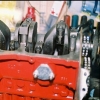Rust On Cylinder Heads
#1

Posted 11 December 2014 - 10:23 PM
#2

Posted 11 December 2014 - 11:00 PM
#3

Posted 11 December 2014 - 11:33 PM
I left mine to soak in some white vinegar from the supermarket for a day or so followed by a rinse and a quick scrub...




#4

Posted 11 December 2014 - 11:47 PM
Coca cola.
#5

Posted 12 December 2014 - 01:50 AM
If your cylinder head (or engine block) is as badly rusted as the ones shown above you should consider scrapping them. You may be able to remove all of the rust (unlikely), but the severe pitting pictured above may render them impossible to seal sufficiently to prevent coolant or combustion chamber leakage.
Edited by newenglandmini, 12 December 2014 - 01:52 AM.
#6

Posted 12 December 2014 - 03:25 AM
Coca cola.
Bhahaha,,,,, didn't Myth Busters bust this one?
I use Acid, but looking at the resuslts for timmy850's work, I might switch.
I've also use malossis, very slow but only cast iron comes out, completely clean.
#7

Posted 12 December 2014 - 03:45 AM
If your cylinder head (or engine block) is as badly rusted as the ones shown above you should consider scrapping them. You may be able to remove all of the rust (unlikely), but the severe pitting pictured above may render them impossible to seal sufficiently to prevent coolant or combustion chamber leakage.
I only grabbed this one from the scrap pile because I thought I'd have a go at a little bit of porting and I didn't want to ruin my other head when learning ![]() Although with a skim to up the compression ratio and some bigger valves I don't think there would be a problem using it again. I am considering using it as a decorative piece on my desk at work too
Although with a skim to up the compression ratio and some bigger valves I don't think there would be a problem using it again. I am considering using it as a decorative piece on my desk at work too
#8

Posted 12 December 2014 - 12:06 PM
#9

Posted 12 December 2014 - 01:26 PM
All cleaning methods will affect something. If the head looks that rusty you should plan on replacing the guides as part of the rebuild. Likewise, you should plan on having at least the bottom surface of the head skimmed during the rebuild to remove the pitting.
Google for the following cleaning methods. All work and each has its advantages.
Molasses rust removal,
Electrolysis rust removal,
Phosphoric acid rust removal.
I have not used molasses but have seen the results on heavy parts. It does work but it is slow.
Electrolysis works very well. It is faster than molasses but you will have to make electrodes to reach some areas (it works basically by line of sight between electrodes so getting into ports and cooling jackets can be problematic).
Phosphoric acid is the "industrial" version of what goes on if you use Coca-Cola or another soda. Phosphoric acid will remove the rust but to be effective you need to really, really degrease the part well first and you need to check it often so the chemical attack does not do more harm than good.
If you have time, try molasses. If you have a bit less time and want to be involved in the process, try electrolysis. If you are in a hurry, try phosphoric acid and be involved in the process... soak for a while, then scrub with a wire brush... followed by more soaking as necessary.
#10

Posted 12 December 2014 - 05:14 PM
#11

Posted 12 December 2014 - 05:37 PM
Coca cola.
Bhahaha,,,,, didn't Myth Busters bust this one?
I use Acid, but looking at the resuslts for timmy850's work, I might switch.
I've also use malossis, very slow but only cast iron comes out, completely clean.
Molasses is also very smelly I've heard.
Cola does work but depends what. I've known a few people us it in clogged rads. Don't use the best stuff though ... cheap Alda/Lidl stuff ... and thorough flush through.
#12

Posted 12 December 2014 - 08:54 PM
Molasses is also very smelly I've heard.
Can be, depends on how rust the item is, I'm no chemist, but I'd say the smell is a by-product of the reaction that's going on.
I mentioned that I generally use (Phosporic) Acid and as dklawson has pointed out it's best if the item is cleaned before hand (very true). I use a Cuastic Soda, that I get from the hardware for doing this (Coca Cloa??), it removes grease, oil, grim and paint (in varying degrees), it works even better if this soultion is heated. After the Caustic Bath (Hot Tank we call it), then cleaned down with plain water (since the Caustic is Alkaline) then in to the Acid (Cold Tank). Some particularly rusty items I have found that following the Acid Treatment, they need another quick dip (after washing in water first) in the Caustic. Usually the items then need this second dip come out of the Acid blackened in appearance.
#13

Posted 12 December 2014 - 09:01 PM
#14

Posted 12 December 2014 - 09:31 PM
I used this stuff on all my suspension components and transmission bits. Just add it to water and leave them to soak for a few days.
http://www.ebay.co.u...ff14=108&ff19=0
Edited by Daviewonder, 12 December 2014 - 09:31 PM.
#15

Posted 12 December 2014 - 11:55 PM
Or just buy some Bilthamber DEOX c, put a scoop in a bucket of water, dump the head in and two days later job done.
Another one for Deox-c absolutely brilliant stuff ![]()
http://www.bilthambe...eatments/deox-c
1 user(s) are reading this topic
0 members, 1 guests, 0 anonymous users






















